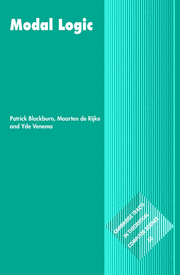Book contents
- Frontmatter
- Dedication
- Contents
- Preface
- 1 Basic Concepts
- 2 Models
- 3 Frames
- 4 Completeness
- 5 Algebras and General Frames
- 6 Computability and Complexity
- 7 Extended Modal Logic
- Appendix A A Logical Toolkit
- Appendix B An Algebraic Toolkit
- Appendix C A Computational Toolkit
- Appendix D A Guide to the Literature
- References
- List of Notation
- Index
3 - Frames
Published online by Cambridge University Press: 05 July 2014
- Frontmatter
- Dedication
- Contents
- Preface
- 1 Basic Concepts
- 2 Models
- 3 Frames
- 4 Completeness
- 5 Algebras and General Frames
- 6 Computability and Complexity
- 7 Extended Modal Logic
- Appendix A A Logical Toolkit
- Appendix B An Algebraic Toolkit
- Appendix C A Computational Toolkit
- Appendix D A Guide to the Literature
- References
- List of Notation
- Index
Summary
As we saw in Section 1.3, the concept of validity, which abstracts away from the effects of particular valuations, allows modal languages to get to grips with frame structure. As we will now see, this makes it possible for modal languages to define classes of frames, and most of the chapter is devoted to exploring this idea.
The following picture will emerge. Viewed as tools for defining frames, every modal formula corresponds to a second-order formula. Although this second-order formula sometimes has a first-order equivalent, even quite simple modal formulas can define classes of frames that no first-order formula can. In spite of this, there are extremely simple first-order definable frame classes which no modal formula can define. In short, viewed as frame description languages, modal languages exhibit an unusual blend of first- and second-order expressive powers.
The chapter has three main parts. The first, consisting of the first four sections, introduces frame definability, explains why it is intrinsically second-order, presents the four fundamental frame constructions and states the Goldblatt-Thomason Theorem, and discusses finite frames. The second part, consisting of the next three sections, is essentially a detailed exposition of the Sahlqvist Correspondence Theorem, which identifies a large class of modal formulas which correspond to first-order formulas. The final part, consisting of the last section, studies further frame constructions and gives a model-theoretic proof of the Goldblatt-Thomason Theorem. With the exception of the last two sections, all the material in this chapter lies on the basic track.
Information
- Type
- Chapter
- Information
- Modal Logic , pp. 123 - 187Publisher: Cambridge University PressPrint publication year: 2001
